APT i ataki ukierunkowane
Spot the Difference: Earth Kasha's New LODEINFO Campaign And The Correlation Analysis With The APT10 Umbrella
LODEINFO is a malware used in attacks targeting mainly Japan since 2019. Trend Micro has been tracking the group as Earth Kasha. We have identified a new campaign connected to this group with significant updates to their strategy, tactics, and arsenals.
This blog is based on a presentation by the authors at Virus Bulletin 2024.
Introduction
LODEINFO is a malware used in attacks targeting mainly Japan since 2019. Trend Micro has been tracking the group as Earth Kasha. While some vendors suspect that the actor using LODEINFO might be APT10, we don’t have enough evidence to fully support this speculation. Currently, we view APT10 and Earth Kasha as different entities, although they might be related. To avoid confusion caused by names, we use a new term “APT10 Umbrella," which represents a group of intrusion sets related to APT10 (including APT10 itself).
Earth Kasha has been known to have targeted public institutions and academics with spear-phishing emails since their emergence. From early 2023 to early 2024, however, we identified a new campaign with significant updates to their strategy, tactics, and arsenals.
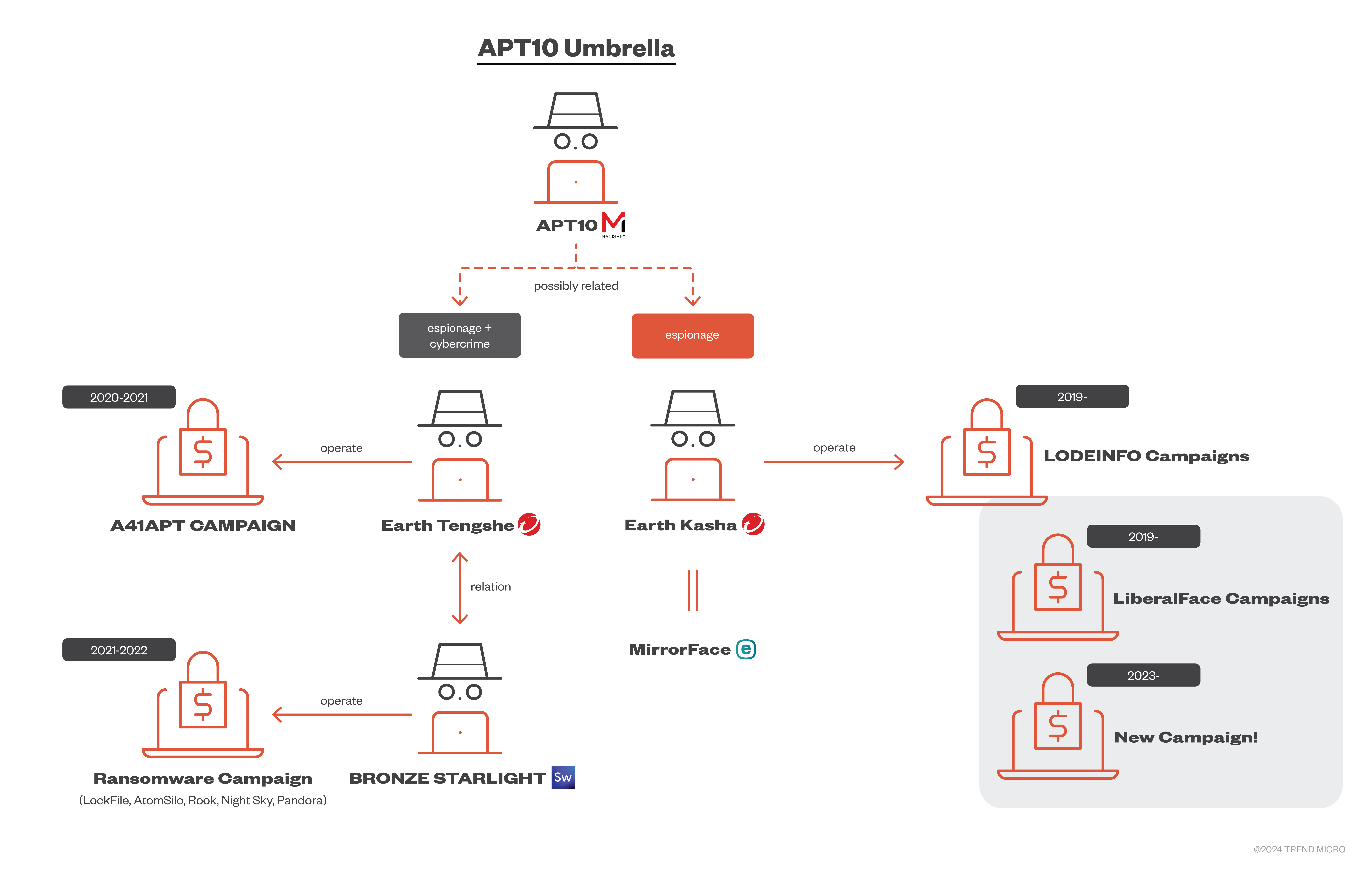
LODEINFO Since 2023
In the new campaign starting in early 2023, Earth Kasha expanded their targets into Japan, Taiwan, and India. Based on the bias of the incident amount, while we believe that Japan is still the main target of Earth Kasha, we observed that a few high-profile organizations in Taiwan and India were targeted. The observed industries under attack are organizations related to advanced technology and government agencies.
Earth Kasha has also employed different Tactics, Techniques, and Procedures (TTPs) in the Initial Access phase, which now exploits public-facing applications such as SSL-VPN and file storage services. We observed that vulnerabilities of enterprise products, such as Array AG (CVE-2023-28461), Proself (CVE-2023-45727) and FortiOS/FortiProxy (CVE-2023-27997), were abused in the wild. Earth Kasha was changing these vulnerabilities to abuse from time to time. After gaining access, they deployed several backdoors in the victim's network to achieve persistence. These include Cobalt Strike, LODEINFO, and the newly discovered NOOPDOOR, which we will describe later.
Observed TTPs in Post-Exploitation
Our comprehensive analysis of the activities in the Post-Exploitation phase has revealed that the primary motivation behind the attack was the theft of the victim’s information and data. Earth Kasha first discovered Active Directory configuration and domain user information to achieve this goal using legitimate Microsoft tools, such as csvde.exe, nltest.exe and quser.exe. The following are actual commands used by the adversary.
- csvde.exe -f all.csv –u
- nltest.exe /domain_trusts
- quser.exe
They then accessed the file server and tried to find documents related to the system information of the customer's network by simply using "dir" commands recursively. Interestingly, upon checking on their activity, the operator might check the content of the documents manually. The stolen information may help the adversary find the next valuable target.
Earth Kasha then performs several techniques to acquire credentials. One method uses their custom malware, MirrorStealer, to dump stored credentials in applications. MirrorStealer (originally reported by ESET) is a credential dumper targeting multiple applications such as browsers (Chrome, Firefox, Edge and Internet Explorer), email clients (Outlook, Thunderbird, Becky, and Live Mail), Group Policy Preferences and SQL Server Management Studio.
Since MirrorStealer may be designed to dump credentials on client machines, Earth Kasha used another way to dump OS credentials. We observed that the adversary abused vssadmin to copy registry hives and ntds.dit in the Active Directory server from volume shadow copy. The SAM registry hive contains the NTLM hash of local machine users, while ntds.dit contains the NTLM hash of all the domain users. The following are commands the adversary uses after creating a volume shadow copy.
- copy \\<AD_SERVER_IP>\c$\windows\temp\ntds.dit .
- copy \\<AD_SERVER_IP>\c$\windows\temp\system .
- copy \\<AD_SERVER_IP>\c$\windows\temp\sam .
While we couldn’t figure out the actual method they abused, we have observed that Earth Kasha successfully compromised domain admin in most cases. After compromising domain admin, they deployed backdoors (LODEINFO or NOOPDOOR) to several machines by copying components over SMB and abusing schetasks.exe or sc.exe to achieve lateral movement. The following are the adversary's actual commands to deploy malicious components over admin shares.
- copy SfsDllSample.exe \\<IP>\c$\windows\temp\SfsDllSample.exe
- copy SfsDll32.dll \\<IP>\c$\windows\temp\SfsDll32.dll
- copy mssitlb.xml \\<IP>\C$\Windows\system32\UIAnimation.xml
- copy ShiftJIS.dat \\<IP>\C$\Windows\system32\ComputerToastIcon.contrast-white.dat
Once the intrusion progressed, Earth Kasha started to exfiltrate the stolen information. The adversary gathered data, including ntds.dit, SYSTEM, SAM registry hives and other interesting files on a single victim machine and compressed these files into a single archive using the makecab command. While we couldn’t confirm how these data would be exfiltrated, it might be over the backdoor channel. Earth Kasha also exfiltrated interesting files in the victim network over the RDP session. They copied interesting files to the RDP source host over SMB (“tsclient” is an RDP source host).
- \\tsclient\C\aaa\All PC List.xlsx
- \\tsclient\C\aaa\All IP List.xlsx
- \\tsclient\C\aaa\Network Diagram.xlsx
Malware Analysis
In the previous campaign by Earth Kasha, LODEINFO has been their primary backdoor of choice. In the new campaign, however, we have observed several backdoors, such as Cobalt Strike, LODEINFO and previously undocumented NOOPDOOR. These backdoors were selectively used for each incident.
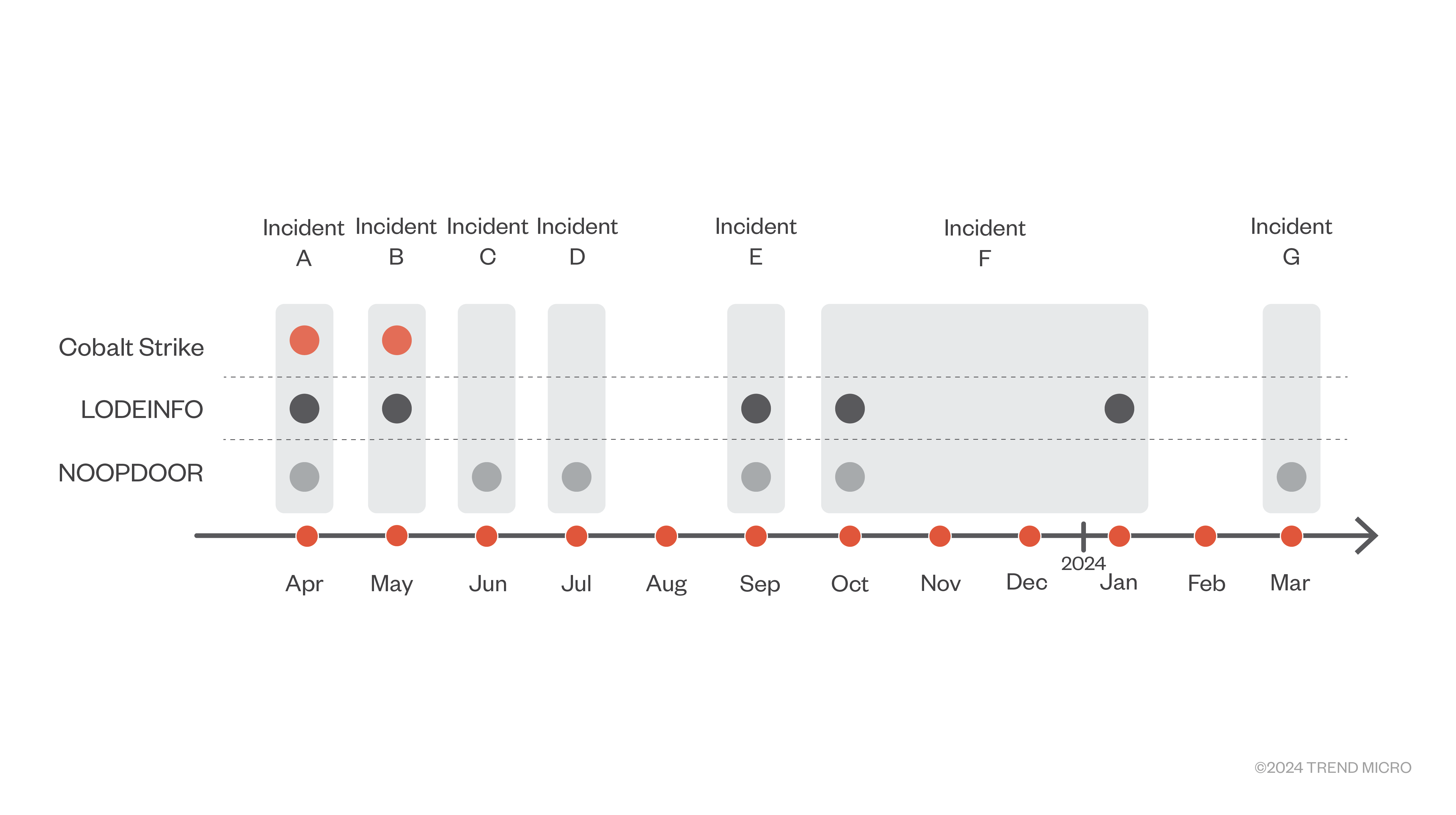
Possible Cracked Version of Cobalt Strike
In the early incidents above, Earth Kasha also used Cobalt Strike. Like other adversaries, Cobalt Strike is designed to be executed only in memory. In this case, Earth Kasha used a shellcode loader written in Go, which we dubbed GOSICLOADER. GOSICLOADER is intended to be loaded via DLL side-loading and simply decrypts the embedded payload in the data section using Based64+AES.
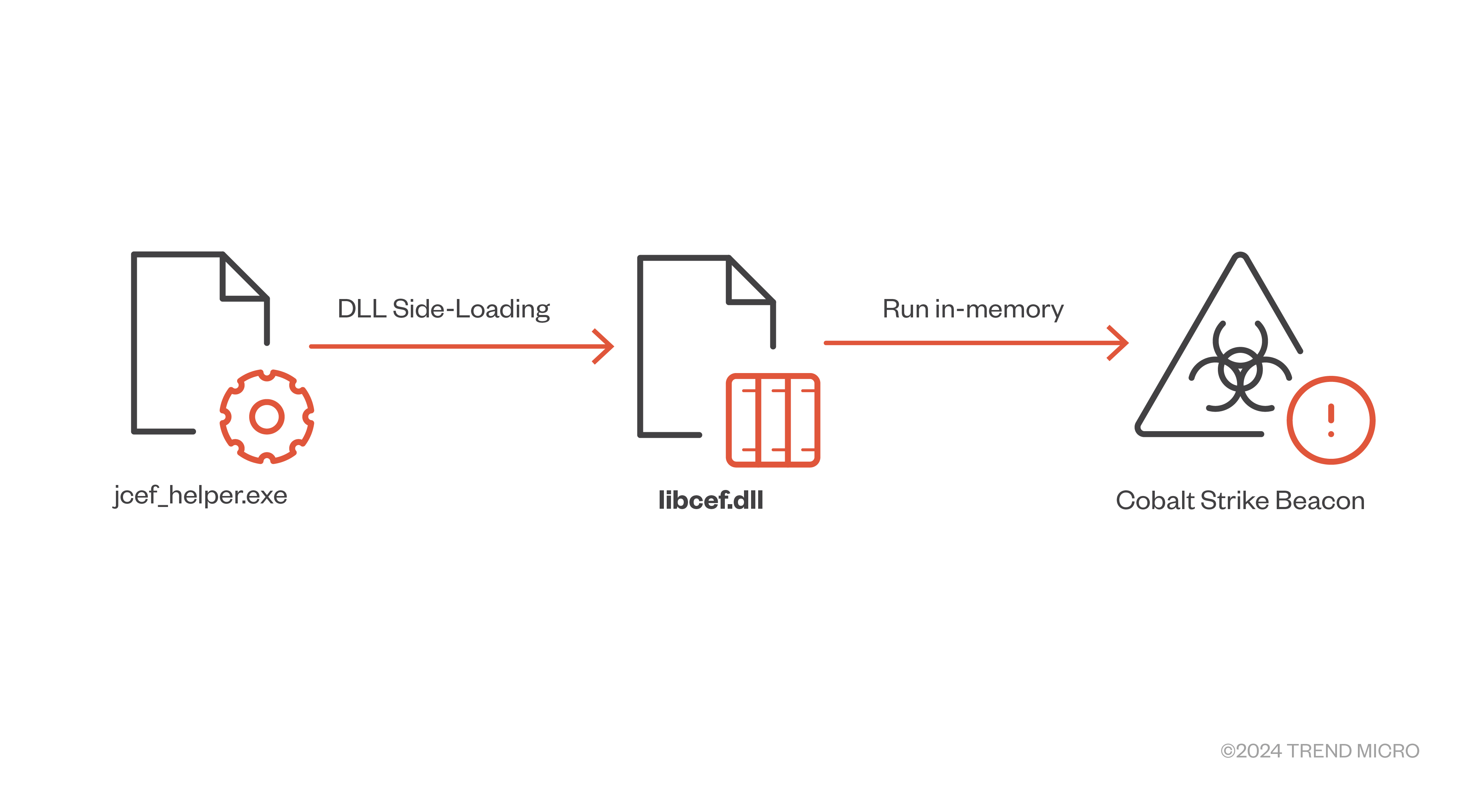
Upon checking the configuration of the Cobalt Strike beacon, we noticed it could be a cracked version of the Cobalt Strike, known as CSAgent, shared among the Chinese-speaking hacking community. According to the developer of Cobalt Strike, Cobalt Strike beacon embeds watermark and watermark hash to make it difficult to tamper with authorization. CSAgent modifies the watermark to include "666666" by default and uses a watermark hash that matches the one embedded in the observed Cobalt Strike beacon for this campaign. Since the watermark and its hash can be easily tampered with if the adversary knows the algorithm, this modification could be a false flag, but it is still noteworthy.

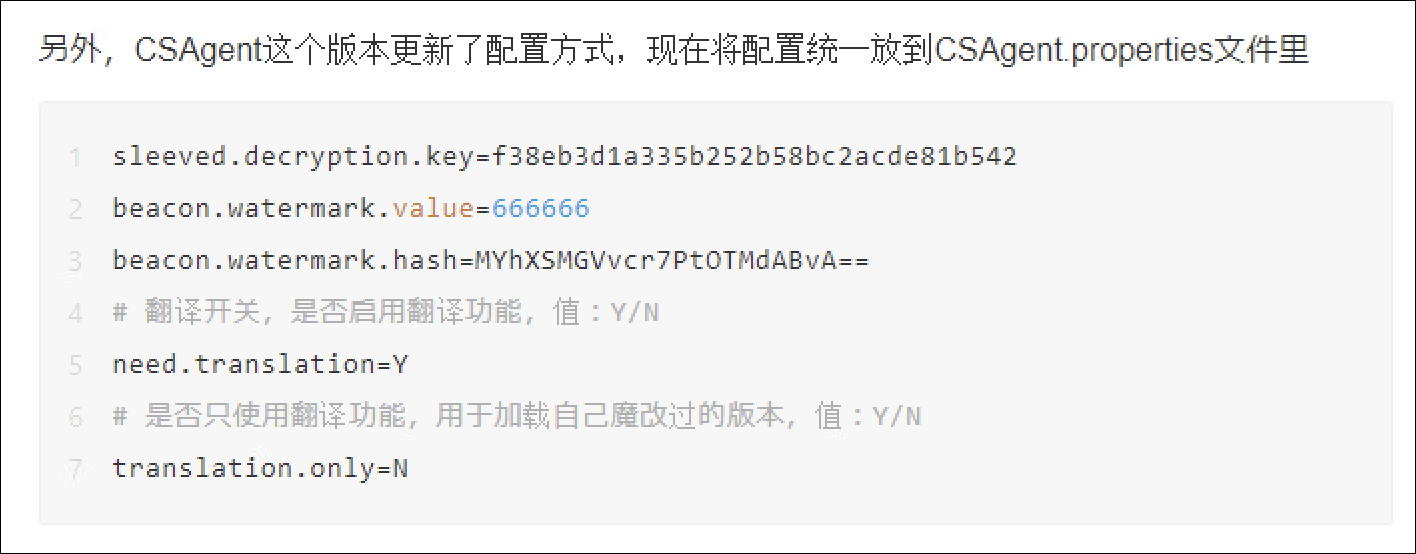
LODEINFO
LODEINFO is a backdoor exclusively used by Earth Kasha since 2019, serving as their primary backdoor. In this new campaign, however, it is just one option among several, showing its adaptability. Since its introduction, LODEINFO has gone through continuous updates, as indicated by its version numbers. In this campaign, we have observed versions v0.6.9, v0.7.1, v0.7.2, and v0.7.3
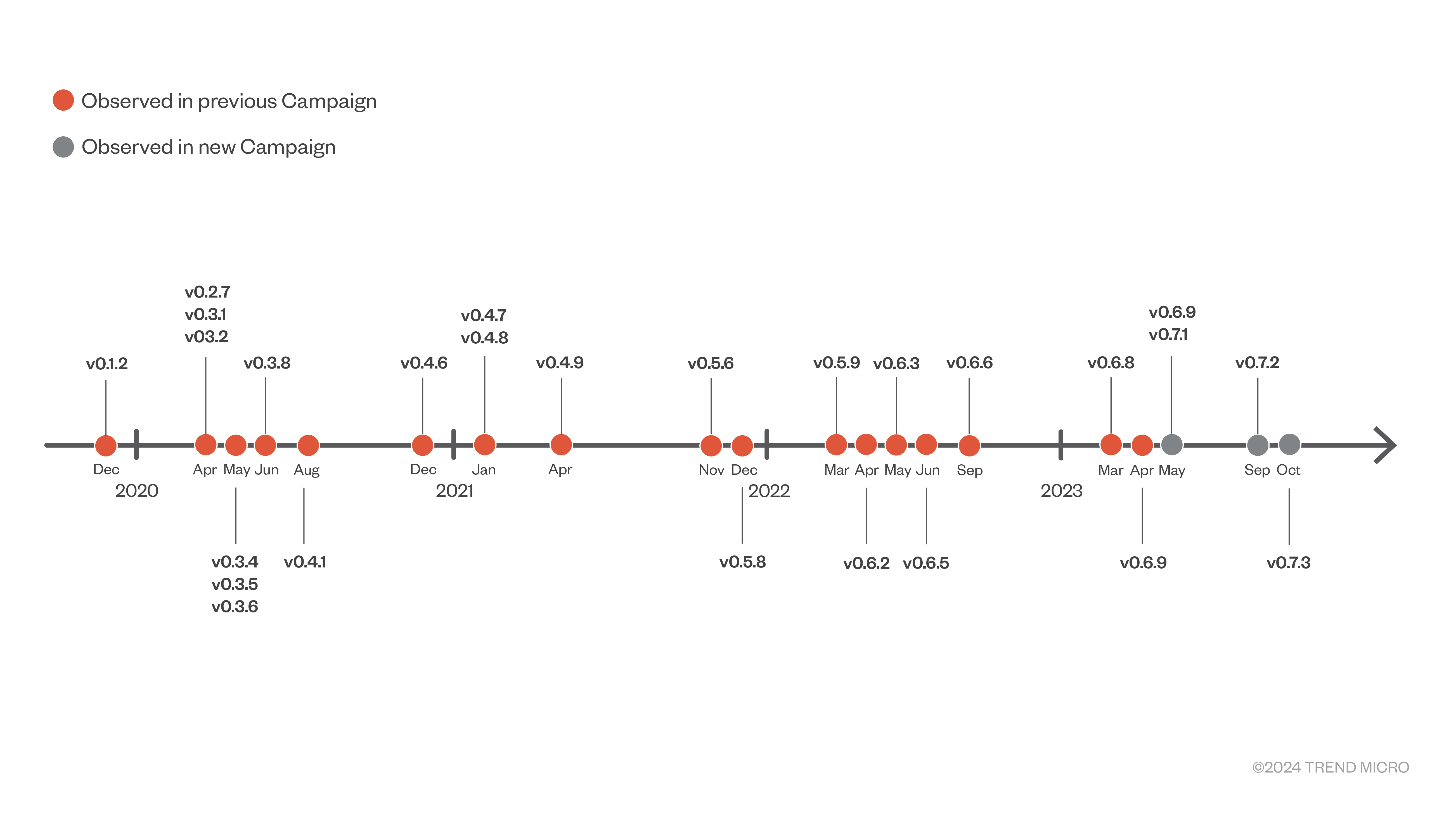
With the incrementing version number, Earth Kasha has also been updating a procedure to execute LODEINFO. In this new campaign, they deployed three components in the victim machine. They registered the legitimate application (SfsDllSample.exe in Figure 7) as a scheduled task, which will trigger DLL Side-Loading of malicious DLL (SfsDll32.dll in Figure 7).
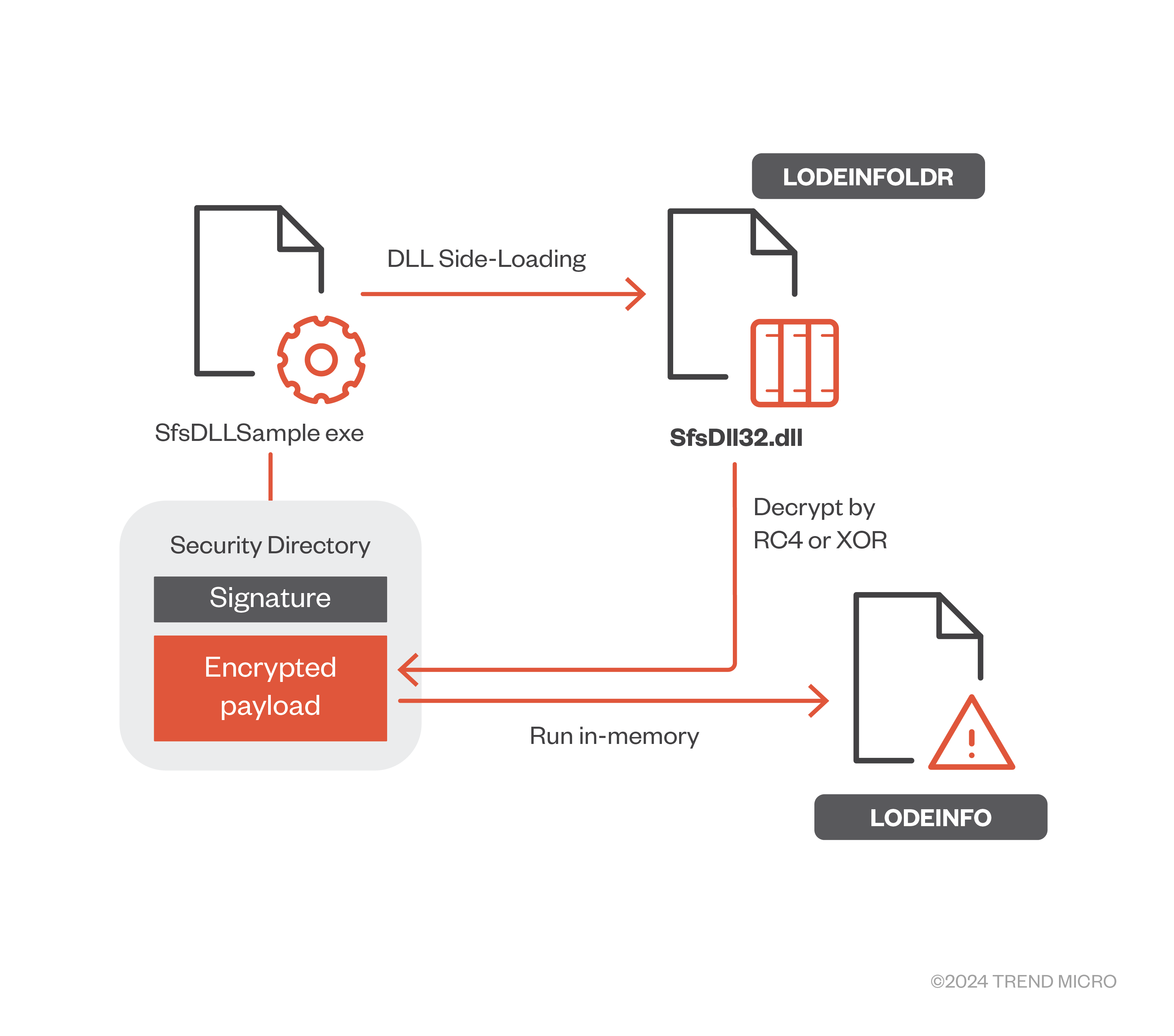
This malicious DLL, which we dubbed LODEINFOLDR (aka FaceLoader by ESET), extracts an encrypted payload embedded in the digital signature of the loaded process and decrypts it by RC4 or XOR. The encrypted payload is embedded in the legitimate digital signature by abusing MS13-098/CVE-2013-3900.
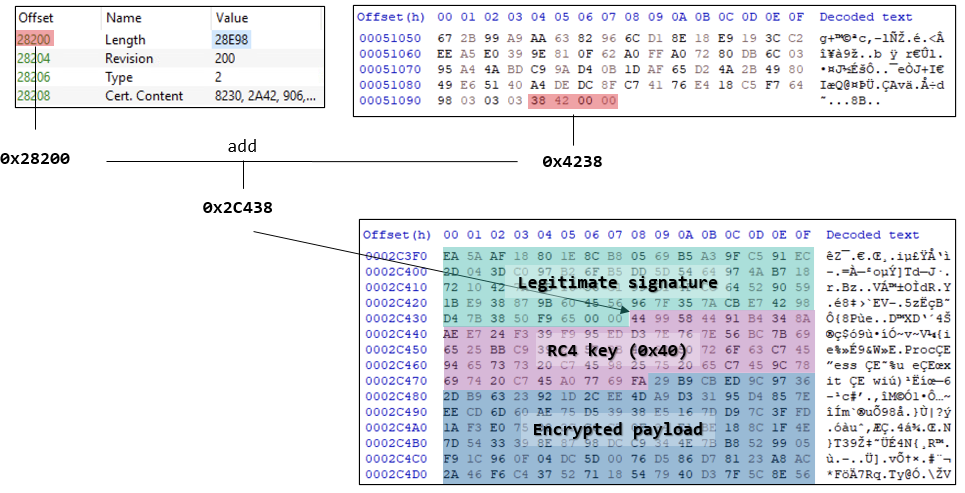
We distinguish this LODEINFOLDR in the new campaign from the ones we had seen in the previous campaign, and we call this new loader LODEINFOLDR Type 2. At first glance, we thought LODEINFOLDR Type 2 was their new loader developed for the new campaign. Still, after further investigation, we identified that LODEINFOLDR Type 2 looks the same as the loader of LODEINFO used in the LiberalFace campaign in 2022, disclosed by ESET3. This may infer that the same entity has used the same malware since the previous campaign.
Regarding LODEINFO, several backdoor commands were newly supported. “pkill”, “ps”, “keylog”, and “autorun” were added in v0.6.9, and “runas” was newly added in v0.7.1. The backdoor commands supported in v0.6.9 differed from the old ones since these commands were initially added in the previous version, removed in v0.6.3 and added again in v0.6.9. On the other hand, “runas” supported in v0.7.1 is a new one that enables running the processes as a specific user. Since v0.7.2, the "config" command, which is just used to display “Not Available.”, has been fully implemented.
| v0.6.9 | v0.7.1 | v0.7.2 and v0.7.3 |
| command ls rm mv cp cat mkdir send recv memory kill cd ver ransom (not implemented) comc config pkill ps keylog autorun |
command ls rm mv cp cat mkdir send recv memory kill cd ver ransom (not implemented) comc config pkill ps keylog autorun runas |
command ls rm mv cp cat mkdir send recv memory kill cd ver ransom (not implemented) comc config pkill ps keylog autorun runas |
Table 1. Backdoor commands supported by LODEINFO, newly added commands in italics
All the LODEINFO we observed in the new campaign were slightly different in the backdoor command process compared to the LODEINFO in the previous campaign. This LODEINFO type supports running DLL or shellcode in memory without backdoor command processing. After further investigation, we concluded that this type of LODEINF we observed in the new campaign should be the same as the one that ESET calls “The 2nd stage LODEINFO” observed in the LiberalFace campaign. As Figure 9 and Figure 10 show, the LODEINFO in the new campaign directly supports running DLL or shellcode in memory without processing backdoor commands. This evidence may also infer that the same group has been using the same malware since the previous campaign.
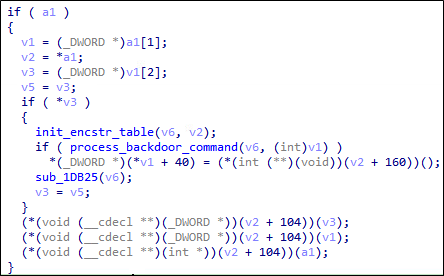
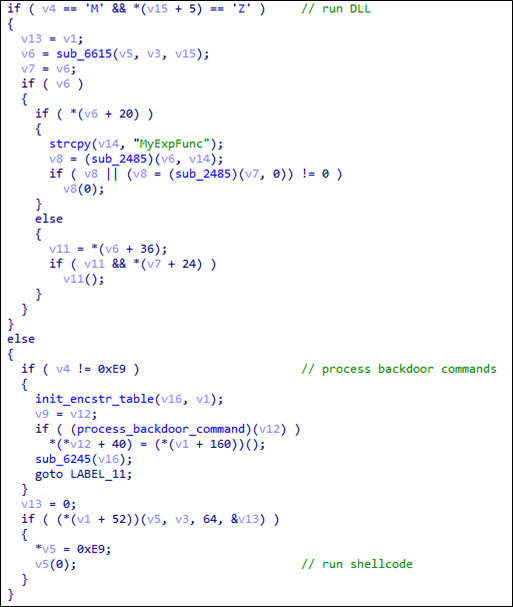
NOOPLDR
During our investigation, we encountered two different shellcode loaders; one is XML containing C#, and the other is DLL. These two types of shellcode loaders are completely different in the implementation perspective. However, a payload of both is a previously undocumented backdoor that we call NOOPDOOR, which we will describe later. Both loaders adopt a similar strategy to decrypt and store the encrypted payload using the machine's device ID. Based on these similarities, we categorized both as the same variant, which we dubbed NOOPLDR. We distinguish the former XML/C# one as “NOOPLDR Type 1” and DLL one as “NOOPLDR Type 2," respectively. NOOPLDR Type 1 is designed to be executed by Windows' trusted utility tool, MSBuild, as shown in Figure 11.
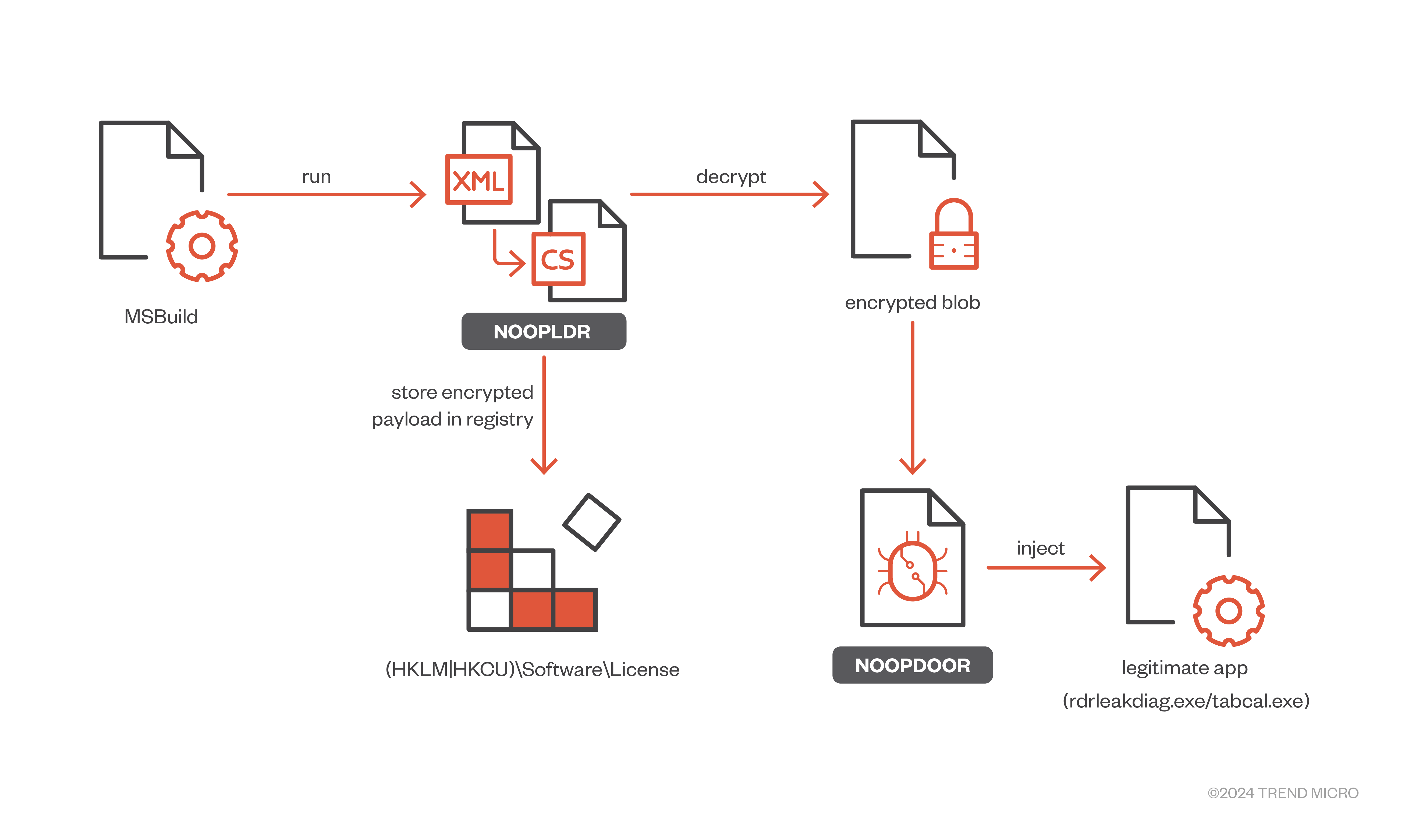
In most cases, MSBuild and the target XML file are registered as a Scheduled Task for persistence. MSBuild compiles the inclined C# in XML project on runtime, a key component of NOOPLDR Type 1. The inclined C# code is typically concealed as follows.
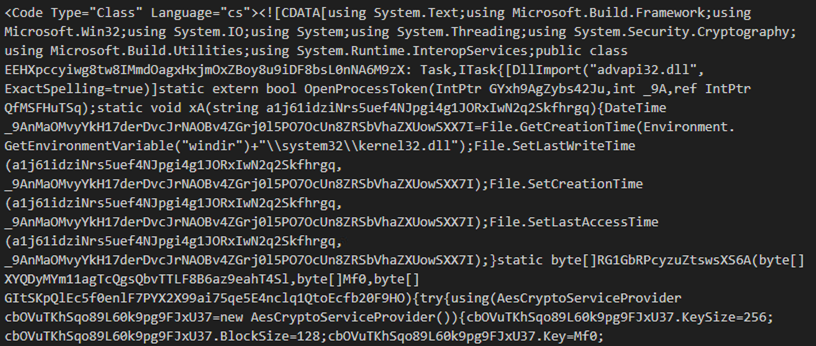
NOOPLDR Type 1 changes its behavior depending on whether it’s the first-time execution or otherwise. If it’s the first execution, NOOPLDR Type 1 tries to find encrypted data from a hardcoded file path, which differs for each NOOPLDR sample. If it exists, NOOPLDR Type 1 deletes the file after reading the content. The encrypted data consists of a header for checksum, AES key materials and an encrypted body. NOOPLDR Type 1 reads the first 32 bytes, computes the SHA256 hash of the following encrypted body, and then compares the hash with the header to verify if the data is an expected structure. After completing verification, NOOPLDR Type 1 calculates the SHA384 hash of the AES key material following behind the checksum header. The first 32 bytes are used as the AES key, and the later 16 as IV. Finally, NOOPLDR Type 1 decrypts the encrypted payload by AES256-CBC.
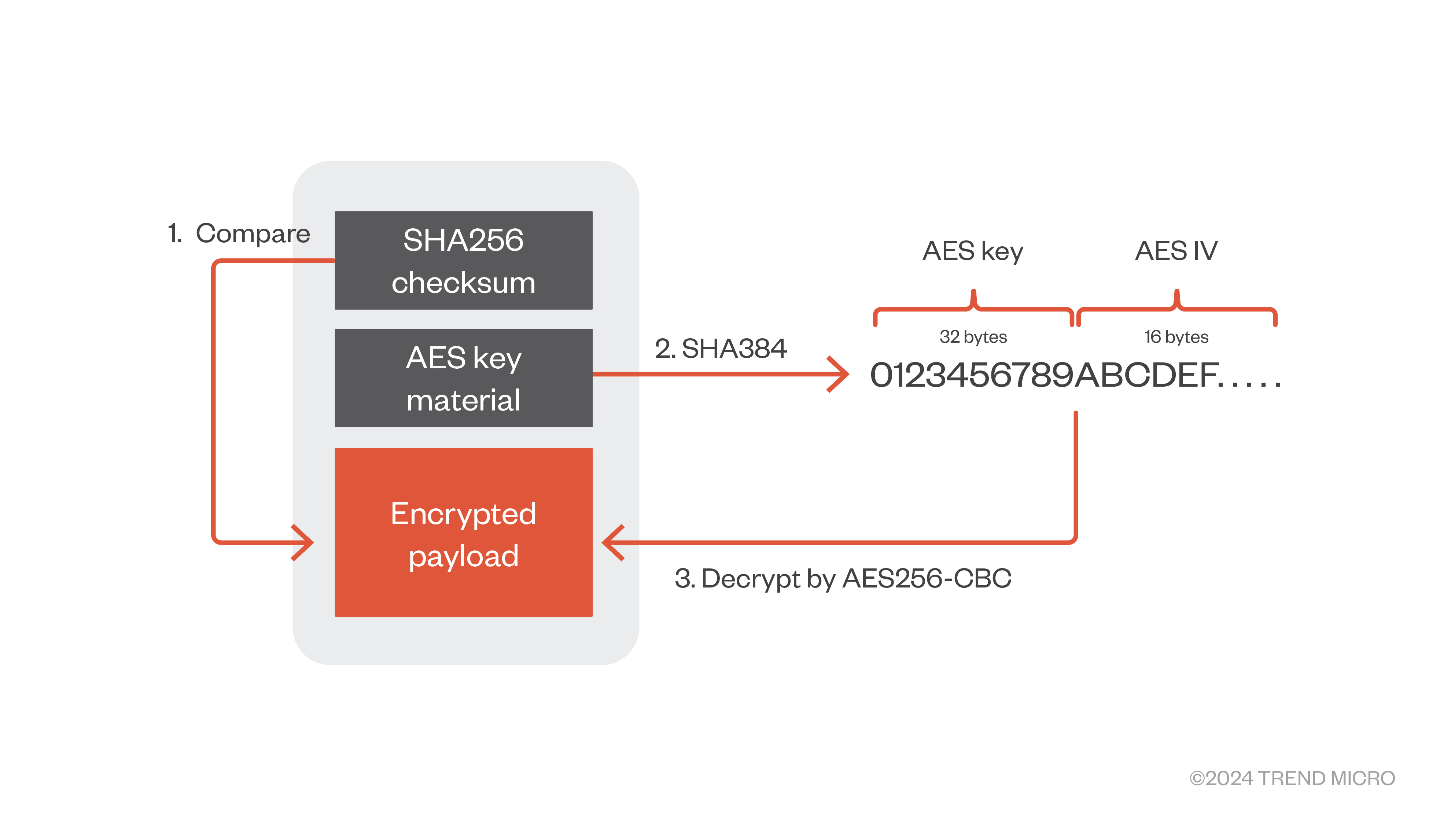
The decrypted data has a header containing a 64-bit flag, the payload size, an offset to the payload and the payload data in the following structure.

Once the decryption succeeds, NOOPLDR Type 1 tries to store the payload in the registry for stealthy persistence. The encryption algorithm is still AES256-CBC, but the AES key and IV are generated based on a machine’s Device ID and a hostname. The device ID is retrieved from the registry key “HKLM\Software\Microsoft\SQMClient\MachineId," which contains the machine's unique GUID. NOOPLDR Type 1 calculates the SHA384 hash of the concatenated Device ID and hostname and follows the same procedure in the decryption routine, splitting the hash value into chunks of 32 bytes and 16 bytes for AES key and IV respectively.
NOOPLDR Type 1 then prepends the SHA256 hash of the encrypted payload and stores it in the registry "(HKLM|HKCU)\Software\License\{HEX}”, which “HEX” is a hex string of the last 16 bytes of the SHA256 hash of the hostname. Since this encryption procedure uses a unique value for each infected machine, we need to preserve additional info and data, such as registry hive and hostname, to smoothly decrypt the payload. If NOOPLDR Type 1 successfully stores the payload in the registry, it deletes the encrypted file on a disk. Therefore, in the second and subsequent execution time, NOOPLDR Type 1 reads the registry key and decrypts the payload in the same procedure as the encryption routine.
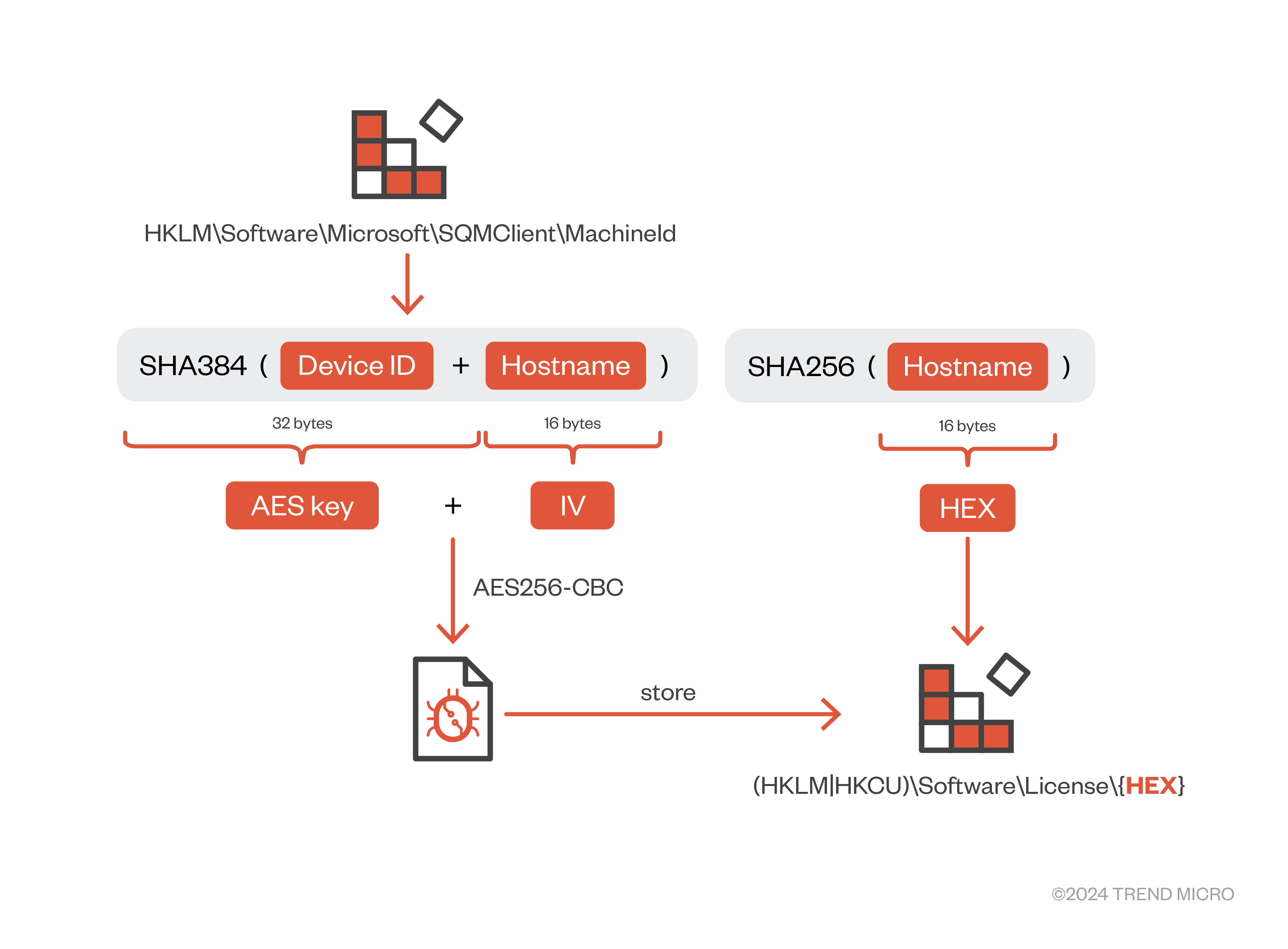
In the final step, NOOPLDR Type 1 injects and runs the decrypted payload into a legitimate application, such as rdrleakdiag.exe and tabcal.exe. If NOOPLDR Type 1 fails to store the payload in the registry, it writes the encrypted payload into a disk again and overwrites it with the same timestamp as the built-in kernel32.dll.
Another type of NOOPLDR in the form of a DLL, which we call NOOPLDR Type 2, adopts a similar strategy to Type 1 but implements more stealthy techniques. As Figure 16 illustrates, during the first execution, NOOPLDR Type 2 also decrypts the encrypted payload from a file and stores the encrypted payload in the registry. It injects the decrypted payload into the legitimate application.
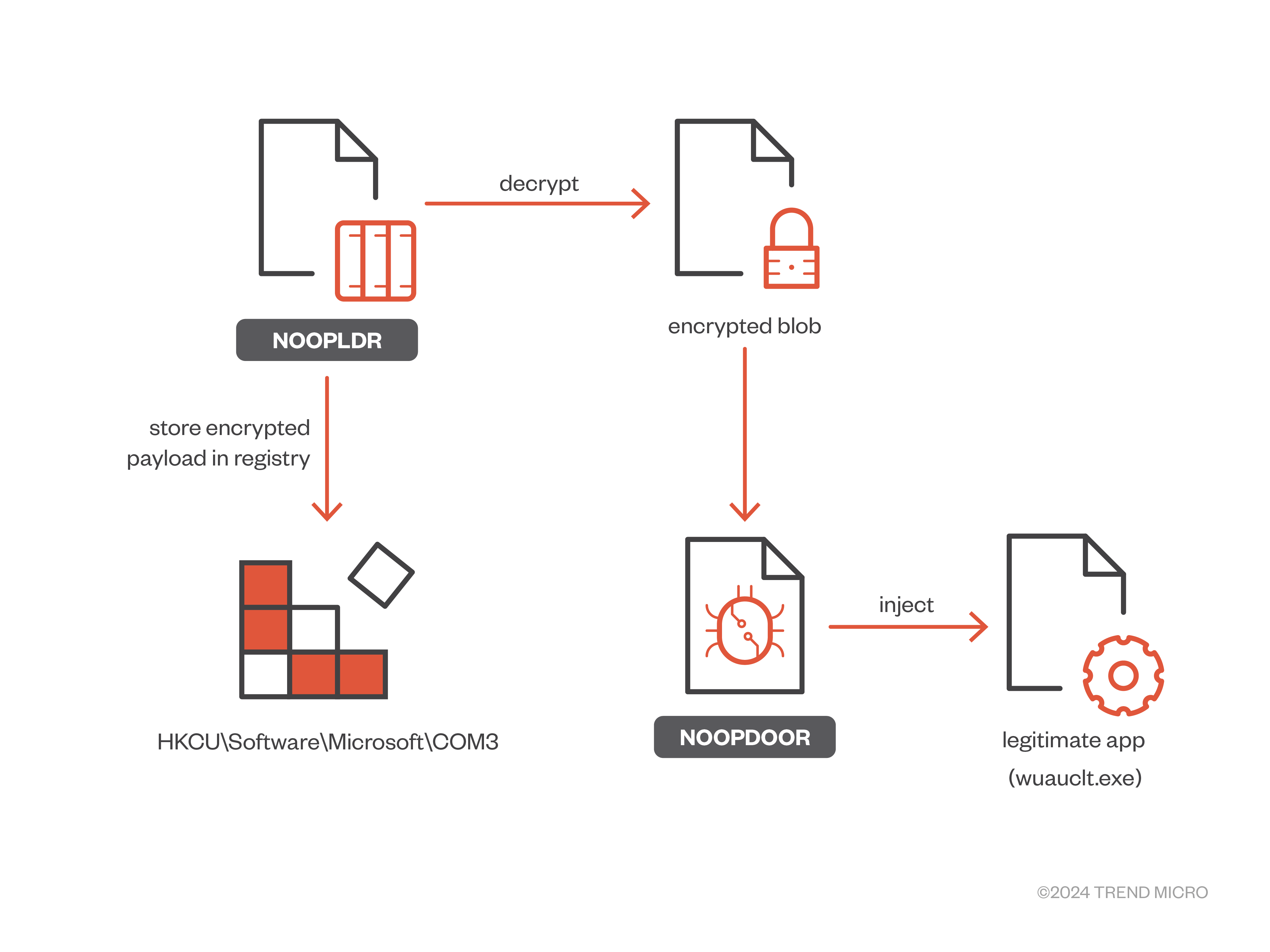
One of the notable features of NOOPLDR Type 2 is the use of multiple anti-analysis techniques. For instance, it is heavily obfuscated by control flow obfuscation and junk codes, as shown in Figure 17. Earth Kasha has already applied this type of obfuscation technique in the previous campaign, but even before that, it’s been popular among China-nexus adversaries, such as APT10 and Twisted Panda.
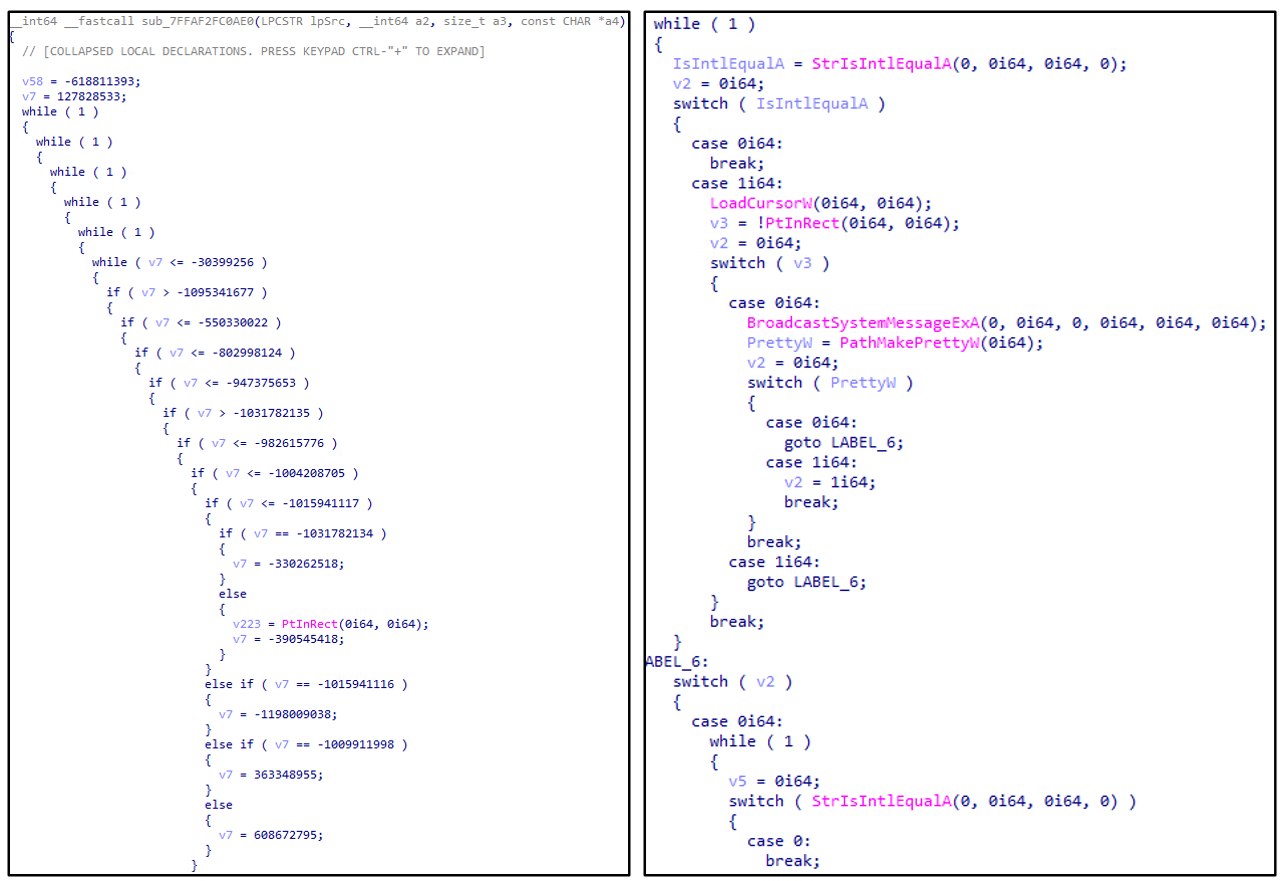
For the additional anti-analysis technique, most strings are simply encoded by XOR, which is decoded on runtime.

NOOPLDR Type 2 is designed to be executed via DLL Side-Loading. NOOPLDR Type 2 supports self-installation as Windows Service by running with the "-install" parameter. During the first execution, it loads an encrypted payload named “<LOADER_PROCESS_NAME>_config” in the current working directory, which will be deleted after installation. For instance, if the loader process name is “symstore.exe," the encrypted file would be "symstore.exe_config." The encrypted blob structure is like the Type 1 but slightly different. It doesn’t have a checksum section; it simply has 32-byte AES key materials followed by an encrypted payload, as Figure 19 shows. The encrypted payload is encrypted by AES256-CBC. The AES key is generated based on the SHA1 of the first 32 bytes, and IV is the first 16 bytes.
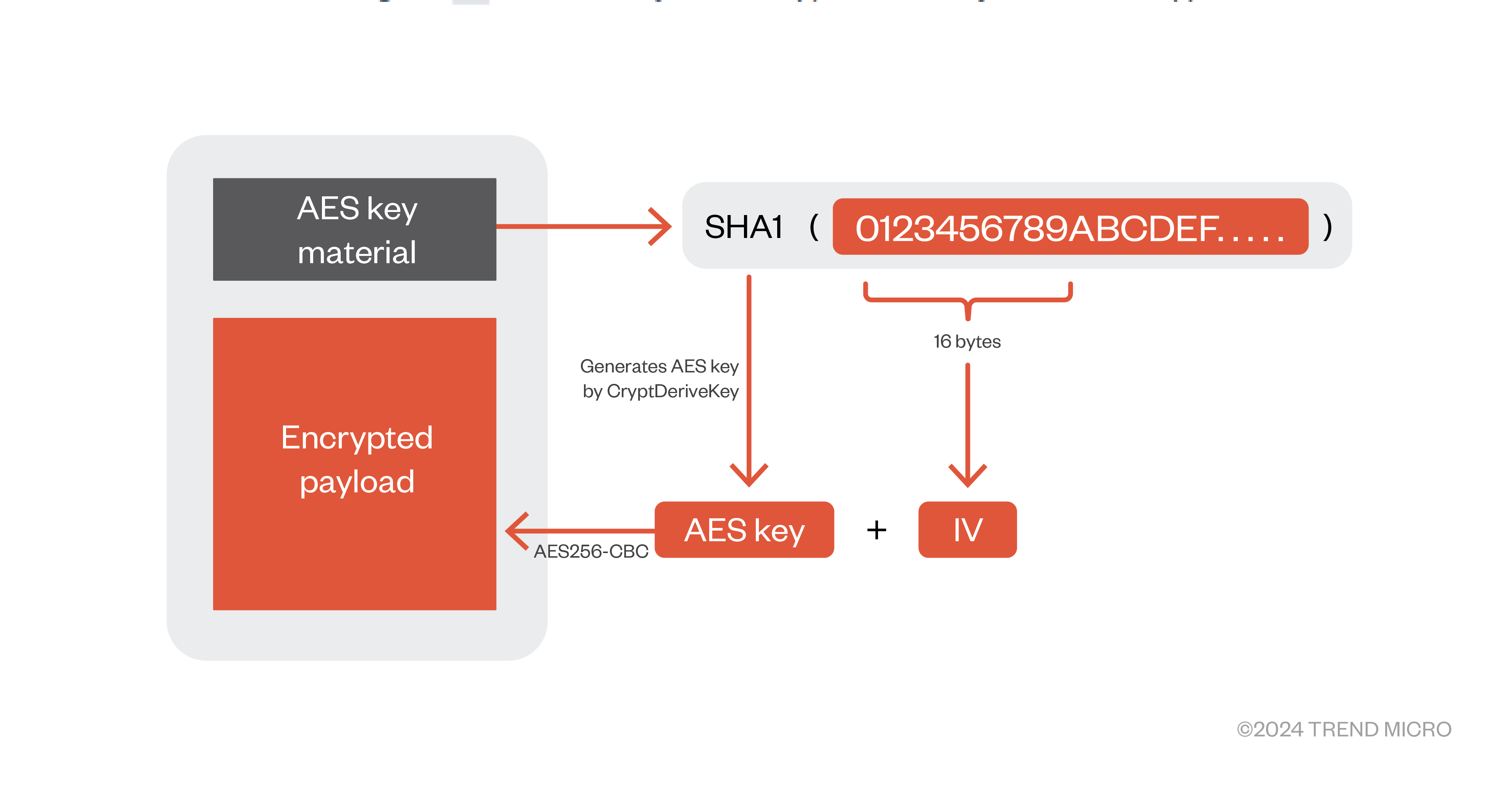
Like the NOOPLDR Type 1, the decrypted data has a 0x14 bytes header containing several values used to verify if it’s an expected structure, as Figure 20 shows.

After verification, NOOPLDR Type 2 encrypts the decrypted data again with AES256-CBC but with a different key, which consists of a Device ID string, hardcoded key material in the code section and randomly generated 8-byte hex string and stores it in “HKCU\SOFTWARE\Microsoft\COM3\<RANDOM_HEX_STRTING>," as Figure 21 shows.
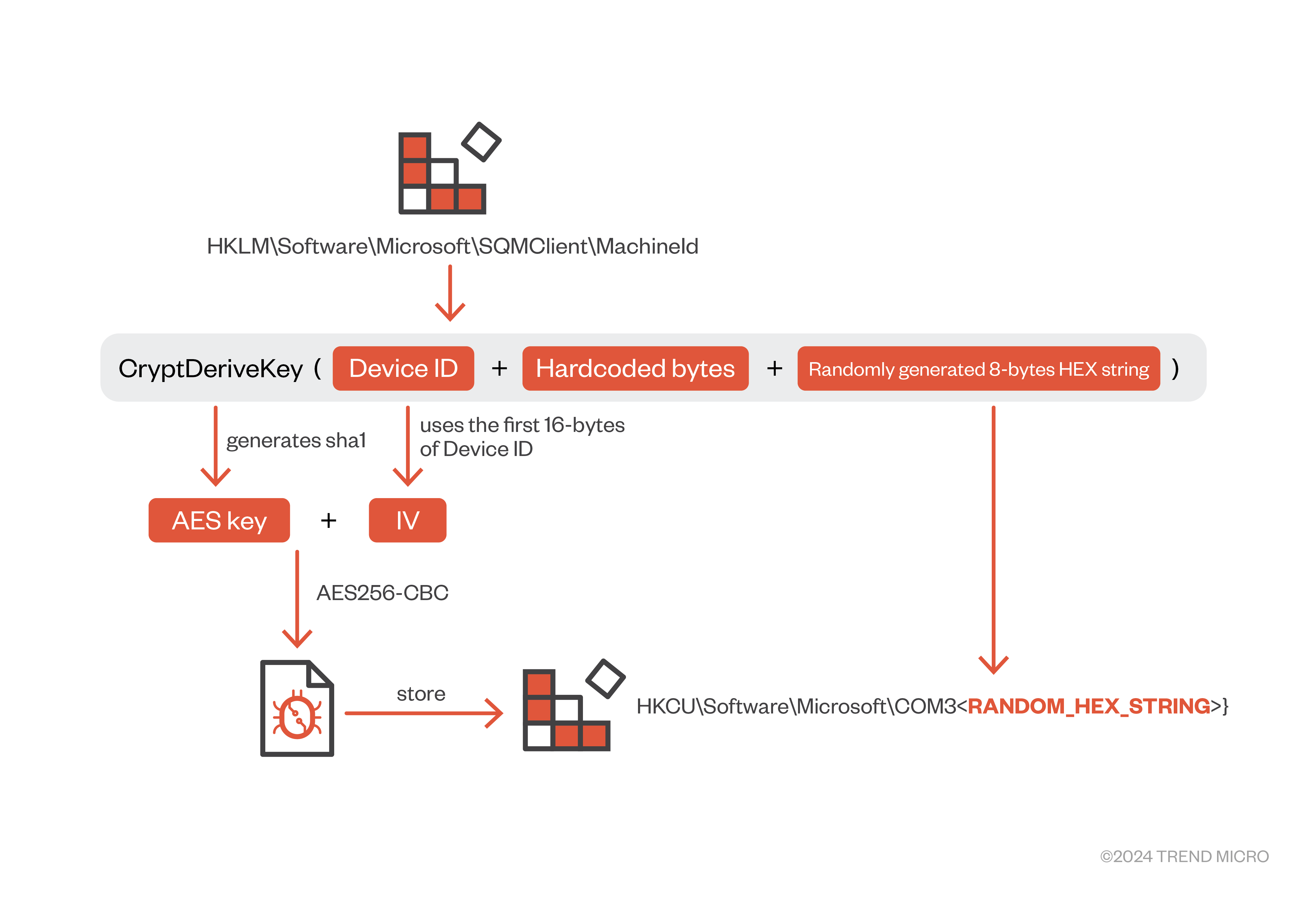
In the second and subsequent execution time, NOOPLDR Type 2 will be executed without the "-install" parameter. Therefore, it skips self-installation and proceeds to the payload decryption routine from the registry. It searches registry data in the registry (HKCU\SOFTWARE\Microsoft\COM3), and if found, it decrypts the encrypted data by the same method in Figure 21 but using the HEX string in the registry key as a part of AES key material.
At last, NOOPLDR Type 2 injects the decrypted payload into legitimate applications, such as wuauclt.exe. This process injection technique is classic, but leverages direct Syscall using NtProtectVirtualMemory, NtWriteVirtualMemory and NtCreateThreadEx. Since Syscall ID can be different on running OS versions, Syscall ID is calculated on runtime.

NOOPDOOR
Now, let’s step into the final payload, NOOPDOOR. NOOPDOOR (aka HiddenFace by ESET) is a sophisticated and complex backdoor with the following characteristics:
- Fully position independent code
- Supporting active and passive mode communication
- C&C domain changed daily by a DGA (by default)
- Proxy-aware TCP communication during working time
- RSA + multiple symmetric cipher to encrypt the entire C&C communication
- Supporting build-in functions + additional modules for backdoor capabilities
- Evading in-memory detection by encrypting/decrypting specific functions on runtime
- Anti-analysis
Due to its complexity, NOOPDOOR should be designed as another backdoor choice, especially for a high-profile target. Based on our records, NOOPDOOR was first observed as a second-stage payload of LODEINFO in 2021, but only in limited cases. And we have not encountered NOOPDOOR until 2023. One of the interesting features of NOOPDOOR is that it supports two channels to communicate with the C&C server, which we call the active and passive modes.
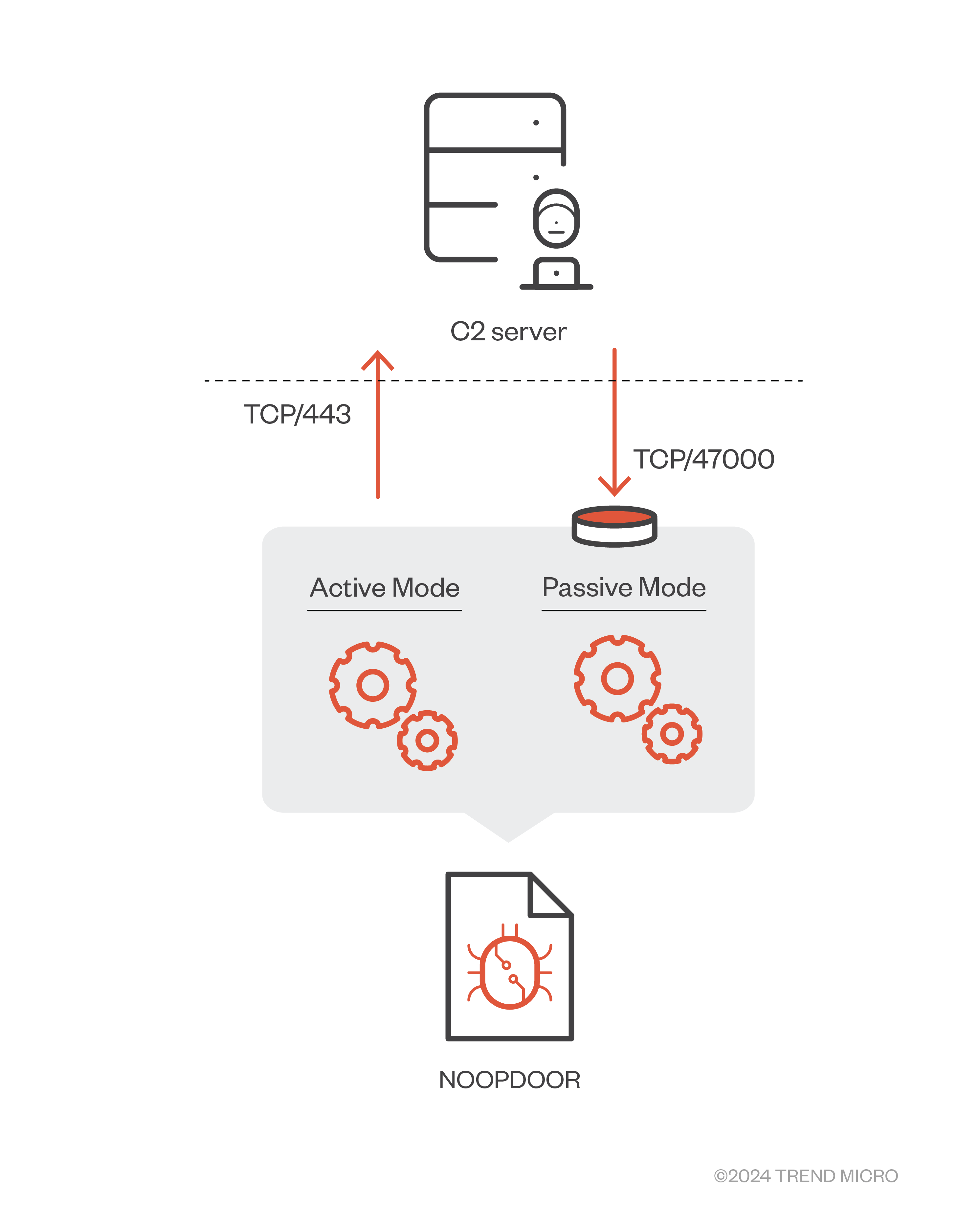
Figure 23 shows that NOOPDOOR in active mode communicates over TCP/443 by polling the C&C server. NOOPDOOR in passive mode listens on TCP/47000 to receive commands from remote adversaries. Interestingly, the active and passive modes use different encryption algorithms and backdoor commands, respectively, which means that both channels are incompatible and independent methods of communication from each other. The active mode is executed in a primary thread of NOOPDOOR. Before starting communications with the C&C server, NOOPDOOR checks if the specific analysis tools listed in Appendix A are running in the current machine. If any are found, NOOPDOOR will terminate itself. NOOPDOOR then generates the C&C server's domain using a custom Domain Generation Algorithm (DGA). NOOPDOOR has template URLs like “http://$j[].srmbr\.com/#180” (defanged) that are used to generate the domain, and NOOPDOOR embeds a randomly generated string based on the runtime date into the template URLs. Therefore, a domain can be changed daily (by default, but the lifespan of domains can be changed based on the option). A detailed DGA logic is as follows.
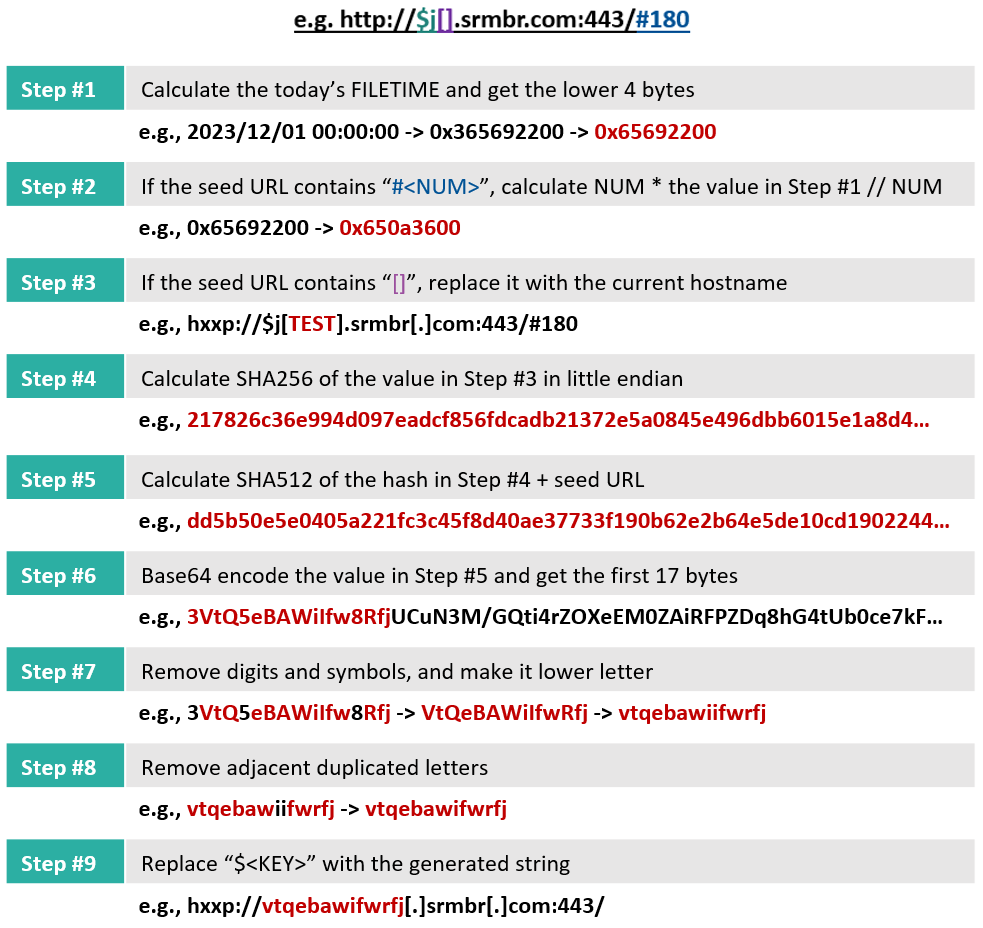
We have also observed a few samples of NOOPDOOR that embed slightly different types of URLs. The placeholder “$<KEY>," which is a single letter (such as “j”) in most cases, can be a "word." In the case we observed, the template URL was like “hxxp://$earth[.]hopto[.]org:443/”, in which the "$earth" part is the placeholder. In such a case, the generated domain will be as follows:
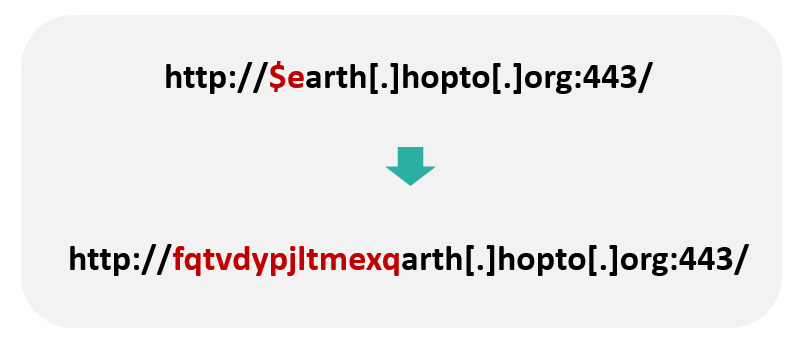
With the generated domain, NOOPDOOR initiates C&C communication. NOOPDOOR supports HTTP proxy in the victim’s environment during business hours (8:30~19:30 from Monday to Friday). C&C communication in the active mode is fully encrypted by a combination of RSA-2048 and symmetric cipher. On initializing a session, NOOPDOOR sends a challenge and randomly selected symmetric cipher ID to the C&C server with encryption by RSA-2048 to negotiate a key for encrypting packets during the following module/command processing. Supported ciphers are DES, 3DES, 2-key 3DES, AES-128-CBC, AES-192-CBC, AES-256-CBC, RC2, and RC4. After key negotiation, it starts to receive commands and sends a result with encryption by the selected cipher.
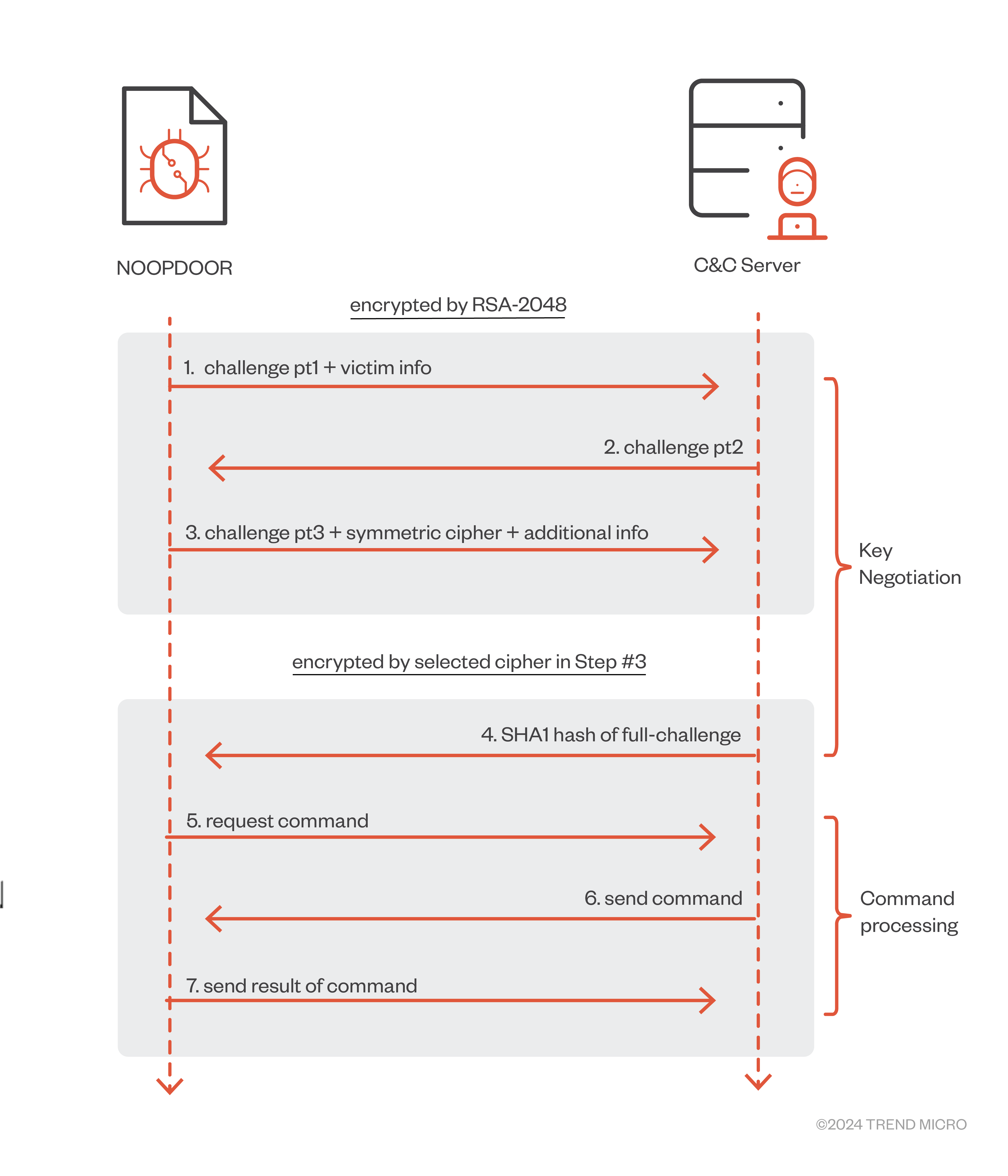
The NOOPDOOR operator can execute a loaded module or built-in function through backdoor commands in active mode. The built-in functions that are currently supported are as follows:
| ID (active mode) | Action |
| 3B27D4EEFBC6137C23BD612DC7C4A817 | Run program |
| 9AA5BB92E9D1CD212EFB0A5E9149B7E5 | Download a file (received from the C&C server) |
| 3C7660B04EE979FDC29CD7BBFDD05F23 | Upload a file (sending to the C&C server) |
| 12E2FC6C22B38788D8C1CC2768BD2C76 | Read specific file (%SystemRoot%\System32\msra.tlb) |
| 2D3D5C19A771A3606019C8ED1CD47FB5 | Change the timestamp of the specified file |
On the other hand, C&C communication in passive mode is much simpler. NOOPDOOR creates a new thread for passive mode communication and prepares an incoming connection. NOOPDOOR initially tries to add a new Windows Firewall rule named “Cortana” to allow inbound connection to TCP/47000. C&C communication in passive mode is encrypted by AES-128-CBC with key and IV generated based on the current running datetime. Backdoor commands are also different from the ones in active mode as follows.
| ID (passive mode) | Action |
| 3049 (0x0BE9) | Keep alive |
| 9049 (0x2359) | Run program |
| 9050 (0x235A) | Upload a file (sending to the C&C server) |
| 9051 (0x235B) | Download a file (received from the C&C server) |
| 9052 (0x235C) | Change working directory |
| 9053 (0x235D) | Run shellcode |
| else | Returns a message “This function is not supported by server!” |
However, it should be noted that the passive mode may be useless in most cases since the operator can’t directly access the listening instance of NOOPDOOR due to a firewall or other network devices in a modern network. The passive mode might be designed for NOOPDOOR being placed in a publicly exposed server (although all the NOOPDOOR have been observed only in a local network so far) or just for testing purposes. In fact, we have observed a few samples of NOOPDOOR that do not implement the passive mode.
As another feature of NOOPDOOR, it supports loading modules from a disk. During initialization, NOOPDOOR looks for a file like "%temp%\{HEX}.tmp," in which the "{HEX}" part is generated from a portion of the SHA256 hash of a combination of the current computer name and username (in UTF-16le). This file contains the modules encrypted by AES-256-CBC. Module blobs consist of metadata, such as information for scheduling, module ID, parameters, and module payload. Due to this feature, NOOPDOOR allows them to execute additional functions at various times (on demand or regularly).
MirrorStealer
MirrorStealer, originally documented by ESET3, is a multi-purpose credential stealer. It is often used in conjunction with NOOPDOOR in cyberattacks. We have observed MirrorStealer in the recent campaign as well. Currently targeted applications are the following.
- Stored credentials in browsers (Chrome, Firefox, Edge, InternetExplorer)
- Stored credentials in email clients (Outlook, Thunderbird, Becky, Live Mail)
- Stored credentials in Group Policy Preferences
- Recently accessed server and stored credentials
- in SQL Server Management Studio (mru.dat, SqlStudio.bin)
All the results of stolen credentials are stored in %temp%\31558.TXT as plain text. We observed that the adversary manually checked the outputs using the "touch” command and deleted them with the “del” command via cmd.exe.
Attribution
As mentioned earlier, we assess the spear-phishing campaign from 2023 to early 2024 to be attributed to Earth Kasha with medium confidence. To explain the reasoning behind our conclusion, we will analyze several campaigns.
LODEINFO Campaign #1 and #2
The following image illustrates the Diamond Model of two campaigns by Earth Kasha. For convenience, we call the campaign being conducted in 2019 to 2023 using spear-phishing as “LODEINFO Campaign #1” and the campaign being conducted since 2023 targeting public-facing applications as “LODEINFO Campaign #2”. The Diamond Model highlights the overlaps between the LODEINFO Campaign #1 and #2, leading us to speculate that these campaigns are operated by the same group because exclusive malware was used in both campaigns. There are no major contradictions in victimology and some parts of TTP.
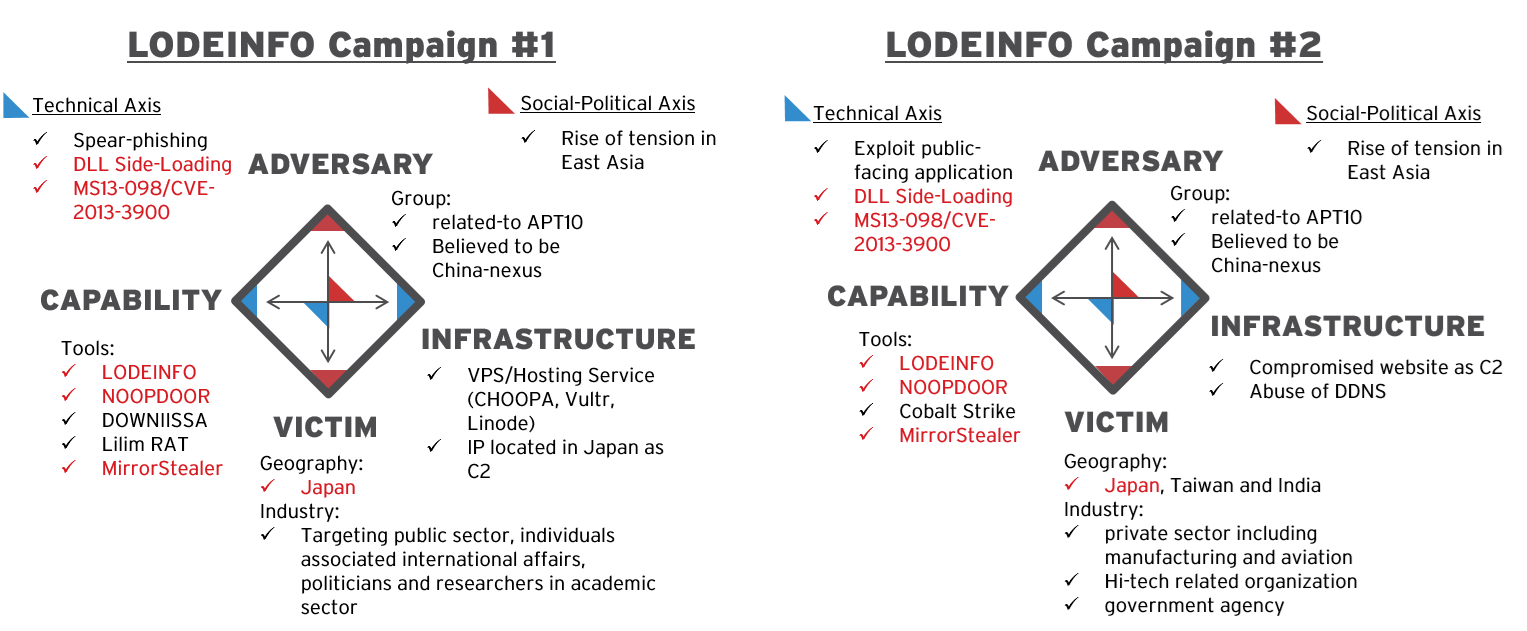
On the other hand, there are several differences between the LODEINFO Campaign #1 and #2, especially in Initial Access methods, which are completely updated. In Campaign #1, they were using spear-phishing for Initial Access, but in Campaign #2, they were exploiting public-facing applications for Initial Access. Regarding victimology, there are some differences in the targeted industry. The public sector, individuals associated with international affairs, politicians, and researchers in the academic sector were targeted in Campaign #1. However, the private sector, including manufacturing and aviation, hi-tech-related organizations, and government agencies, were targeted in Campaign #2.
A41APT Campaign and LODEINFO Campaign #2
We analyzed another campaign, known as “A41APT Campaign” by Earth Tengshe, which is also believed to be related to APT10. This group conducted a campaign targeting several countries, including Japan and Taiwan. The following image uses the Diamond Model to highlight the overlaps between the A41APT Campaign and the LODEINFO Campaign #2.
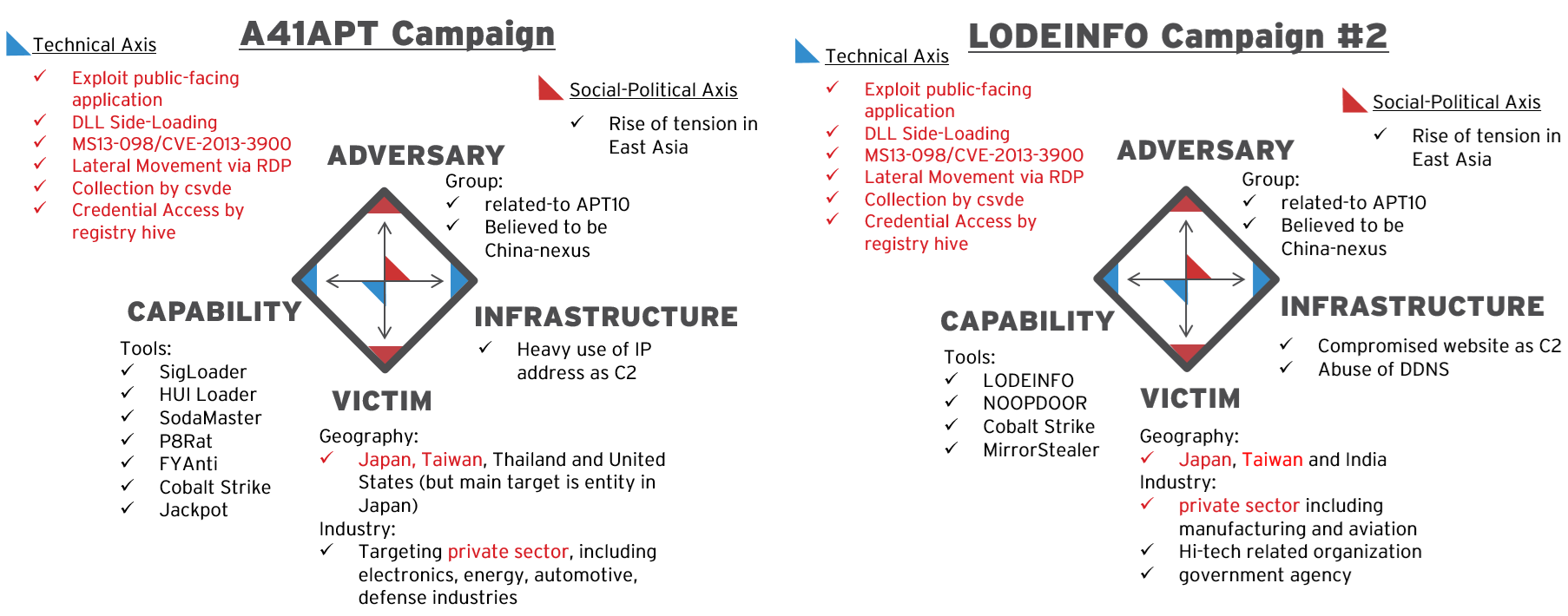
Interestingly, the A41APT Campaign has a lot of overlaps, especially in TTPs of the Post-Exploitation phase. As the presentation on the A41APT Campaign in JSAC2021 shows, there are similar TTPs in both campaigns, such as exploiting SSL-VPN for Initial Access, schedule task abuse for Persistence, RDP by domain admin account for Lateral Movement, abusing csvde.exe to collect Active Directory account information, and dumping registry hives for Credential Access.

The major difference in these campaigns is the toolsets. Earth Tengshe used custom malware, such as SigLoader, SodaMaster, P8RAT, FYAnti, and Jackpot, which completely differ from Earth Kasha's use in LODEINFO Campaign #2.
Considering that Earth Tengshe and Earth Kasha are believed to be associated with APT10, both groups may have relationships in TTPs or may share operator resources. Here is a summary of the comparison between the A41APT Campaign, the LODEINFO Campaign #1 and #2.
| A41APT Campaign | LODEINFO Campaign #1 | LODEINFO Campaign #2 | |
| Attribution | Earth Tengshe | Earth Kasha | Earth Kasha |
| Timeline | 2020 - 2021 | 2019 – present | 2023 – present |
| Region | Japan, Taiwan, Thailand, and the United States (but the main target is the entity in Japan) | Japan | Japan, Taiwan, and India |
| Industry | private sector, including electronics, energy, automotive, and defense industries | public sector, individuals associated with international affairs, politicians and researchers in the academic sector | - private sector, including manufacturing and aviation - Hi-tech related organizations - government agencies |
| TTPs | - Exploit public-facing application - DLL Side-Loading - MS13-098/CVE-2013-3900 to embed encrypted payload |
- Spear-phishing email - DLL Side-Loading - MS13-098/CVE-2013-3900 to embed encrypted payload |
- Exploit public-facing application - DLL Side-Loading - MS13-098/CVE-2013-3900 to embed encrypted payload |
| Tools | - SigLoader - HUI Loader - SodaMaster - P8Rat - FYAnti - Cobalt Strike - Jackpot |
- LODEINFO - NOOPDOOR - DOWNIISSA - Lilim RAT - MirrorStealer |
- LODEINFO - NOOPDOOR - Cobalt Strike - MirrorStealer |
Other Campaigns
Adding to these campaigns, we have observed a few other campaigns that slightly show some overlaps with the LODEINFO Campaign #2.
Our first observation in 2023 shows that the Initial Access and Target methods resemble those of the LODEINFO Campaign #2. This unclustered campaign targeted mainly Japan and abused an exploitation against public-facing applications for Initial Access. Additionally, we confirmed that both campaigns used the same IPs as the origin of exploitation. On the other hand, we didn’t observe any malware or hacking tools during this unclustered campaign. The adversary employed LOLBins in Post-Exploitation, not malware.
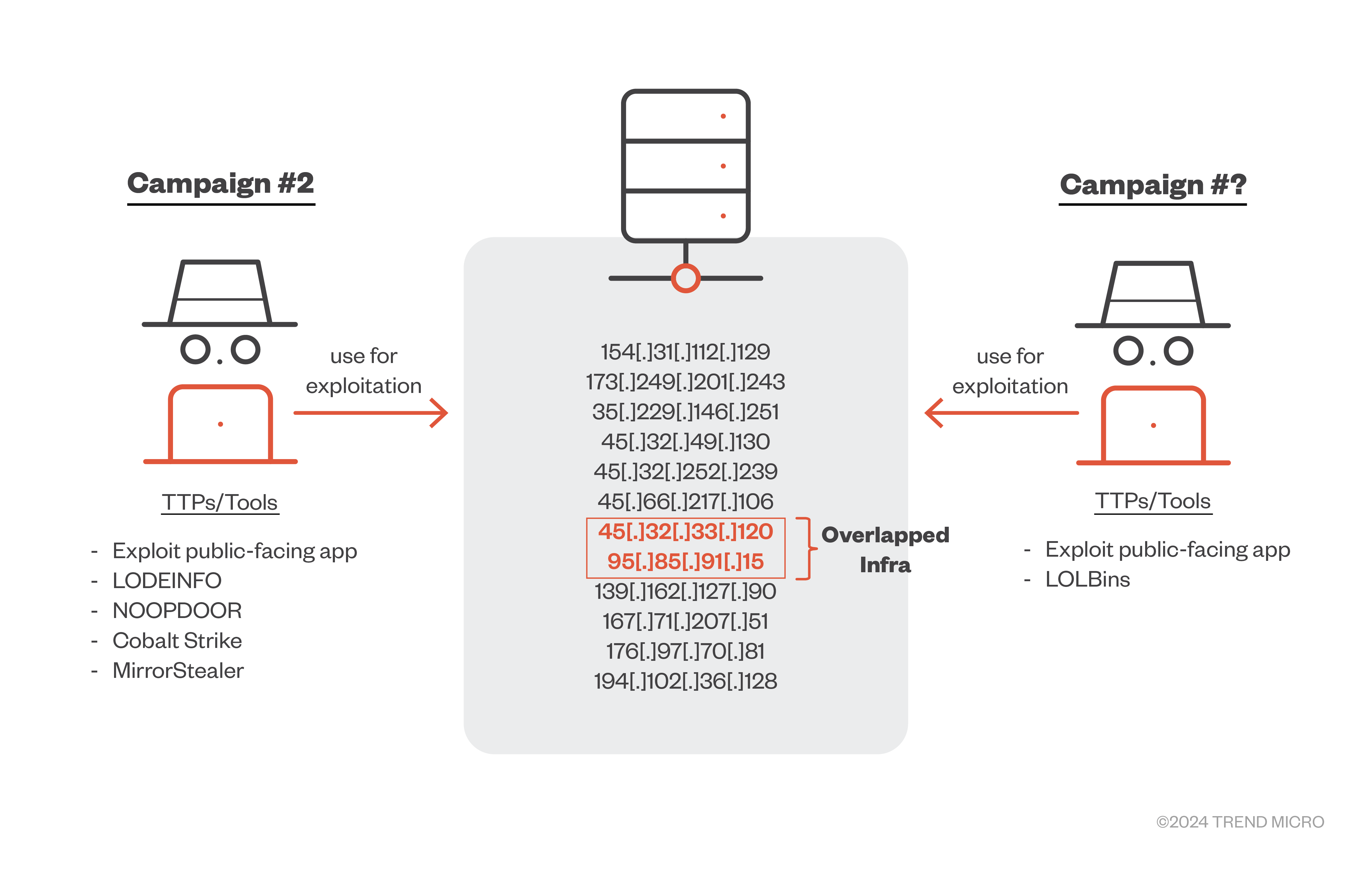
Furthermore, Volt Typhoon, which is a state-sponsored actor based in China documented by Microsoft, was reportedly carrying out the exploit against FortiOS/FortiProxy (CVE-2023-27997), which was also used in the LODEINFO Campaign #2 in 2023. However, TTPs and toolsets in Post-Exploitation were totally different between Volt Typhoon and Earth Kasha (instead, the previously mentioned unclustered campaign looks similar, but no commonalities have been confirmed so far). The vulnerability of CVE-2023-27997 was 0-day at the time of usage in both campaigns by Volt Typhoon and Earth Kasha, leading us to the assumption that the 0-day vulnerability was possibly shared or there might be a third-party entity, such as access brokers, specialized in facilitating Initial Access. This is not the only case indicating the possibility of 0-day vulnerability sharing.
LAC reported the multiple campaigns, abusing Array AG (CVE-2023-28461) and Citrix (CVE-2023-3466, CVE-2023-3467, CVE-2023-3519), which were abused in the LODEINFO Campaign #2 in 2023 as well. Besides the vulnerabilities, however, there are no overlaps in malware and TTPs in Post-Exploitation between the LODEINFO Campaign #2 and these campaigns. This case suggests the possibility of 0-day sharing or the presence of an access broker, indicating that Earth Kasha may be part of such an ecosystem.
Trend Micro Vision One Threat Intelligence
To stay ahead of evolving threats, Trend Micro customers can access a range of Intelligence Reports and Threat Insights within Trend Micro Vision One. Threat Insights helps customers stay ahead of cyber threats before they happen and better prepared for emerging threats. It offers comprehensive information on threat actors, their malicious activities, and the techniques they use. By leveraging this intelligence, customers can proactively protect their environments, mitigate risks, and respond effectively to threats.
Trend Micro Vision One Intelligence Reports App [IOC Sweeping]
- Spot the difference: Earth Kasha's new LODEINFO campaign and the correlation analysis with the APT10 umbrella
Trend Micro Vision One Threat Insights App
- Threat Actors:
- Emerging Threats: Spot the difference: Earth Kasha's new LODEINFO campaign and the correlation analysis with the APT10 umbrella
Trend Micro Vision One Search App
Trend Micro Vision One customers can use the Search App to match or hunt the malicious indicators mentioned in this blog post with data in their environment.
Malware Detection Associated with Earth Kasha
eventName:MALWARE_DETECTION AND malName:(*NOOPLDR* OR *NOOPDOOR* OR *LODEINFO*)
More hunting queries are available for Vision One customers with Threat Insights Entitlement enabled.
Conclusion
We have revealed the new campaign by Earth Kasha and provided an in-depth analysis of LODEINFO, NOOPDOOR and other malware. Additionally, we have analyzed several campaigns in the past and present, suggesting a connection with the previous LODEINFO campaign (LODEINFO Campaign #1) and interesting overlaps with the A41APT Campaign by Earth Tengshe, which is also believed to belong to APT10 Umbrella. These findings lead us to conclude that the same group that conducted the previous LODEINFO campaign also conducted the recent LODEINFO campaign (LODEINFO Campaign #2) with significant TTPs updates. The group may be incorporating or sharing TTPs and tools with Earth Tengshe. Furthermore, our correlational analysis of several campaigns, including the ones by the Volt Typhoon and other unclustered groups, suggested that the 0-day vulnerabilities may be shared among China-nexus actors, or there may be third-party access brokers.
Our research on the recent activity by Earth Kasha highlighted the current complex situation and potential cooperative relationships among China-nexus threat actors. Such a situation will likely continue because it’s beneficial for the adversaries on effective operation and hard for threat intelligence analysts on the attribution. We all need to understand the current complex background and carefully work on the attribution process.
- Appendix A: Checked Applications for Anti-Analysis by NOOPDOOR
- x32dbg**.exe
- x64dbg**.exe
- llydbg**.exe
- windbg**.exe
- ida*.exe
- idaq*.exe
- ImmunityDebugger*.exe
- ProcessHacker*.exe
- Stud_PE*.exe
- pexplorer*.exe
- Autoruns*.exe
- procexp*.exe
- Procmon*.exe
- Tcpview*.exe
- 010Editor*.exe
- WinHex*.exe
- Wireshark*.exe
- zenmap*.exe
- ProcessHacker*.exe
- vmmap*.exe
- load_sc*.exe
- HttpAnalyzerStd*.exe
- Fiddler*.exe
Appendix B: Indicators of Compromise (IoCs)
The indicators of compromise can be found here:

